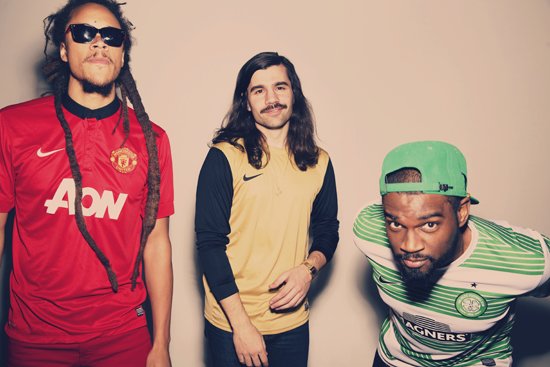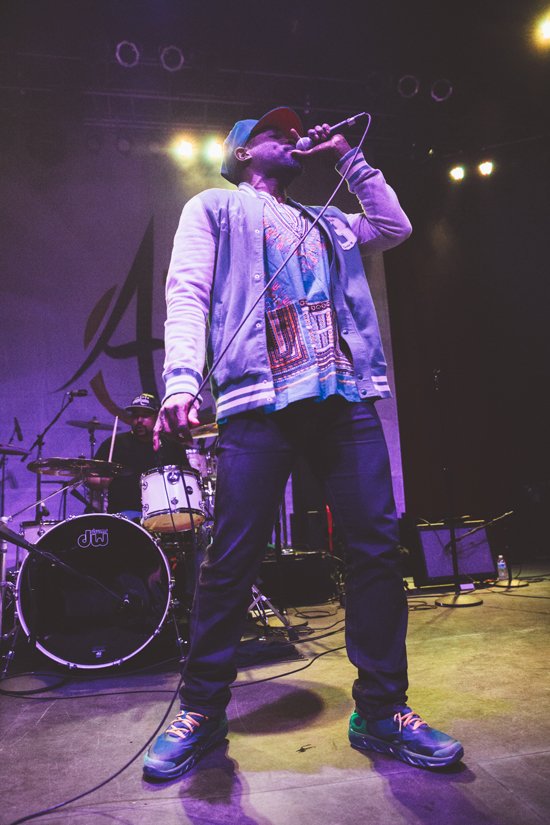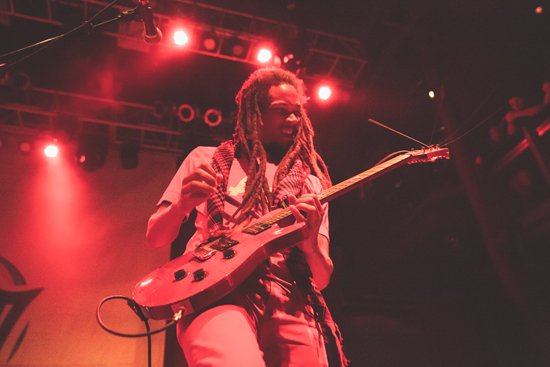Taking a break from recording a new album, Reston’s indie-go-go band RDGLDGRN talks beats, Colors and Pharrell Williams.
By Tim Regan
RDGLDGRN doesn’t have a gimmick. At least, that’s what the three members who compose the Reston-based indie go-go band would tell you. On the surface, they’re band, pronounced red-gold-green, is kind of gimmicky. For starters, the band’s members—named “Red,” “Gold” and “Green”—only dress in those namesake colors, all the time. And if you’re having trouble wrapping your head around the concept, think of it this way—it’s like the Power Ranger uniforms or the Ninja Turtle headbands. One color equals one identity.
For the guys, tackling that issue is sort of a recurring theme. Actually, it’s something they have to address all the time. Last December, Washington Post writer Mark Jenkins devoted an article’s entire opening paragraph to the band’s color-coded outfits. “RDGLDGRN [showed] up for an interview dressed, respectively, in a red sweater, gold sports jacket and nearly all-green ensemble,” Jenkins wrote. But they’ve got their reasons.
“We didn’t plan this,” says Gold. Red, one of the band’s guitarists puts it this way: “Before we started this band, we had already been living as colors. Some people have tattoos and that define them. Some people have long beards. I wear one color. He wears one color. We wear one color.” In the song “Power Ups,” guitarist and lead vocalist Green even lyricizes, “I see in full color, I just choose to be green.”
The point is this: Judge this band on their musical merits, not the color of their clothes. They’re not a flash in the pan kind of group. They go way deeper than that.
What the F@#! is Indie Go-Go?
We all know indie rock, the genre born out of grunge rock that launched a thousand hipster hits. These days, it’s hard to get away from the stuff. Even Miley Cyrus likes Nirvana. But Indie go-go? That’s a little harder to wrap your head around.
Here’s a crash course: Indie go-go is the combination of indie rock and D.C.’s own brand of hip hoppish, funky-fusion genre, go-go.
“All the rhythms are things that derive from the go-go rhythms,” explains Red. But don’t go looking for the classic, syncopated drum beats a la Trouble Funk or Chuck Brown. Leave that old school stuff for D.C. graffiti celebrity Cool “Disco” Dan and dancehall mixtapes. The songs heard on the band’s EP—released in 2013—are fresh. Hip. Updated.
“It’s newer. It’s a bounce beat. It’s not like classic go-go you might be thinking of … it’s from our generation of go-go,” says Gold. Green demonstrates, beatboxing the rhythm, hand tapping the table. “It’s that boom-gat-gatgat-gat,” boxes Green in rapid succession, “as opposed to [the slower beat of] boom-bap-boom-boombap,” he adds. On top of the beat, guitars jam out danceable indie rock rhythms. Harmonized, deep choruses often accompany leading vocals. The stuff on their new, short EP—expected out this month—is what their manager Reggie Vaval calls “a bit more electronic, but still go go influenced.”
Like a go-go show, their concerts attract throngs of young, energized fans ready to hit the dance floor, but without any of the cliquey callouts or crew showdowns found at traditional go-go shows. On stage, RDGLDGRN jumps, dances and headbangs. But despite heavy rock influences, tracks like “Doing the Most” and “I Love Lamp” contain little rap vignettes courtesy of vocalist Green, while songs “Power Ups” or “Million Fans” are almost exclusively rhythmic rhyme-and-verse. It’s this balance between rapping and jamming that makes the band stand out.
Although influences always creep in. While making “I Love Lamp,” for instance, the band nabbed the beat wholesale from go-go godfathers Backyard Band’s “Thug Passion.” In fact, Red says they just recreated the beat, layered some guitars and vocals on top, and called it a day. But don’t call it thievery. This kind of beat-swiping is fairly common in the world of hip-hop. If anything, it’s an homage to one of D.C.’s fundamental go-go groups.
Reston Roots
This iteration of the band traces its lineage to about a decade ago, when the trio—now pushing 30—all went to South Lakes High School at the same time, though they didn’t actually know each other then.
“You’re bound to know somebody even if you’ve never met them before,” says Gold. “The town is small enough.” And back then, they weren’t officially known as Red, Gold or Green, either. Their civilian names were, respectively, Marcus Parham, Andrei Busuioceanu and Pierre Desrosiers. But as the story goes, they soon dropped those personas for the colorful nicknames.
In their teen years, the bandmates laid the foundation for the future by absorbing D.C.’s hardcore punk and go-go scenes like sponges. “All I did was go to go-gos,” Green says. “If you went to a party, there was a go-go section of that party. Go-go was everywhere.” And if you think NoVA doesn’t have a thriving go-go scene, think again. “You walk around the area and people are listening to [go-go] in their cars,” Red says.
Like most bands, the group met by serendipity. “Someone I played basketball with introduced me to these guys,” says Gold. As soon as they met, they clicked, and began crafting their sound right away. “Since the day I met these guys, we’ve written music [together]. We’ve never stopped writing music,” says Gold.
In 2008, they formed The Five One, a band that included RDGLDGRN’s lineup, plus one more member, “Blue.” They played plenty of local shows and amassed a ton of fans. But their productivity was shoddy, at best—new music came in spurts, followed by periods of radio silence. A few times, the band almost broke up. Fans were kept in the dark and many wondered the status of the band every time they stopped. But slowly, the shows kept trickling in, and the positive reviews were stacking up. In 2011, The Five One planned to release RED BLUE GREEN GOLD, a professional album funded by more than $4,000 in Kickstarter seed money. But then, as quick as the band had appeared on the scene, they broke up.
Among the fan base, there were rumors that a serious blowout happened on Blue’s end. If you ask the members of RDGLDGRN, they’ll say Blue parted ways with the group and leave it at that. Details are murky. “He’s like Nightwing,” says Green, referring to Robin’s rogue alter-ego created out of a serious feud with Batman. “He saw a different way of handling the business, and Batman had his way of doing things.” Basically, he explains, it came down to “creative differences,” the catch-all explanation that follows every band breakup.
Blue, on the other hand, tells a different story. “They went [to] Cali to explore the option of moving forward with The Five One minus Blue,” he wrote on his blog, bluefiveone, in September of 2011, shortly after the breakup. “I didn’t lock them out of our websites, I didn’t cut them out of any revenue, I didn’t try to change the names of the sites to my new project,” he adds.
Just four months after playing their last show as The Five One, the band went into hibernation—sans Blue—and bided their time. After going through the rough patch, the guys felt like the band needed a makeover. They kicked around a few ideas, but eventually landed on the one constant they’d had over the years, their signature colors.
On a whim late one night, they uploaded an early version of “I Love Lamp,” a song originally conceived as a Five One track, to SoundCloud, the social media music sharing site. The song wasn’t finished, and they weren’t ready to unveil it to the world just yet. Green admits that, at that point, they didn’t really understand how SoundCloud worked. Instead of functioning like a storage cloud for song drafts, the platform made everything visible to users, and contrary to what they assumed, nothing the band uploaded was private. Three hours after posting the track, the clicks came, buzz swelled and the band was back in the game, whether they wanted to be or not. It was official: The band’s super secret side project had leaked, and the cat was out of the bag—The Five One was dead. RDGLDGRN was alive.
In that three hours, a blogger picked up the scent. While the band slept, he typed. “Mysteriously, this track wound up in my inbox today,” wrote author “Mueez,” on the music website The Quiet Floor, a blog that focuses on hip hop and indie records. “RDGLDGRN? I don’t remember ever following them. Something about their sound sounded … a lot like this one band that I fell in love with earlier this year: The Five One.” Mueez continues: “It really didn’t click until I heard the singer drop the n-bomb. Only one indie-hipster-rap band has a roster appropriate enough to be able to say that. … It looks like The Five One no longer exists. RDGLDGRN has replaced [them].” Though it unnerved Green a little at the time, he can laugh about it now. “The guy was like, ‘it could only be one band that would do some shit like that,’” he says while laughing. And although their first single dropped without the pomp and circumstance they had hoped for, it garnered attention from some seriously big names.
From Foo Fighters to Pharrell
Though the band attracted plenty of local attention, they also caught the eye of hitmaker Kevin Augunas, who’s worked with Gotye, Edward Sharpe and the Magnetic Zeros and Cold War Kids. In a whirlwind, the trio scored a four-song EP and set to work in the famous Sound City studio in Van Nuys, California. At first, the lavishness was a little foreign for the band—to this day, Green says he records some of his best stuff in his bedroom at his mom’s house. But the more they worked, the more they realized they’d really made it.
“We were staying at Oakwood Apartments [in LA] where Rick James died, where Nirvana stayed when they were recording Nevermind,” says Gold. “It’s a historical place.”
Then, Augunas dropped a bomb on the group: Dave Grohl, Arlington native, Nirvana drummer, Foo Fighters lead singer and all around musical legend, heard their work, liked it and wanted to play drums on their new EP. Needless to say, the guys were ecstatic. “That shit was really fucking cool,” says Red.
Just as Augunas explained would happen, they got the call one random morning—they’d been summoned. Grohl was in the studio setting up. The first thing the band saw when they stepped into the studio was a monster spread of food. “They had Cracker Jacks, Dave’s favorite,” says Gold. Then, they spotted Grohl and some producers chatting at the sound board. They were talking about the production of Grohl’s now-acclaimed documentary on Sound City and its famous board, and trio had mistakenly interrupted. “We kinda walk in, and he’s at the control booth with the engineers,” says Green. But instead of pulling a rockstar move and ignoring the guys, Grohl stood up, walked over to them, and shook their hands. “He introduces himself as if we don’t know who he is, which was super cool,” says Green. After small talk, it was time to get to work—and Grohl killed it. “He worked out like a machine,” says Gold. “He did a lot of songs really quickly.”
“Everything we do is above and beyond our expectations,” says Green. “We work with Dave Grohl. Dave Grohl played in Nirvana.” Then, there was the time they worked with Pharrell Williams, producer, singer, rapper and similarly, another Virginia native. The story goes like this: Pharrell was at a listening party for Universal Republic (now Republic Records), which owns the band’s label, Fairfax Recording. When a RDGLDGRN song came on, Pharrell was intrigued. He liked what he heard.
The band spent three days in the studio with him, hashing out lyrics to the song “Doing the Most.” And despite Red’s assessment that Pharrell wore a “thirty-million-dollar chain the size of Rhode Island,” to the recording sessions, there was little time to gawk at the celebrity. “We were in awe of how he works, and we went to work with him. It wasn’t a time to be supremely enthused.” Pharrel, like Grohl, was humble, generous and nurturing. “We’re all peers now. It’s that vibe,” adds Red.
No Sleep Till Reston
Nowadays, the band spends up to half a year touring the country at shows that include SXSW, Van’s Warped Tour and D.C. 101’s Chili Cook-Off. But when the Reston rockers do return to their hometown, they usually get a few starstruck stares. Once, in a Wal-Mart, Green was approached by a fan looking for a photo to tweet. But that fan was one of the more visible ones. “Sometimes they don’t even approach us, but then they’ll tweet, ‘I just saw Green’” he says. “I was walking my dog around the lake, and a guy stopped me and was like, hey, you’re in that band from Reston,” says Gold. It’s no surprise that a nationally touring act makes ripples in the placid pond from which they came. South Lakes High School in Reston hasn’t spawned many famous alumni. Sure, rapper-producer Benny Blanco, (he produced Katy Perry’s “California Gurls,” Kesha’s “Tik Tok”) once walked its hallways as a teen. And yeah, Michael Jackson—the NBA player, not the musician—graduated from South Lakes in the ‘80s.
Even so, the Reston rockers are arguably the biggest thing to come out of the town in the past decade. And that can feel weird at times, especially when old friends assume they’re too busy to say hello. “Most people think we’re on the road touring … so any time they see you, they’re like, how long are you in town for?” says Gold. “It’s kind of strange to them that we even live here because most people in the music world are New York or L.A.” Despite the professional work, Reston is home base, for now.
And one of these days, the guys say, they’d like to go back to South Lakes and play a show. “We heard recently that a lot of the kids there know us,” says Gold. Green adds, “We don’t understand what South Lakes is like right now. … We gotta go there.” Who knows? Maybe they could inspire the next generation of NoVA musicians the way go-go inspired them.
(July 2014)



